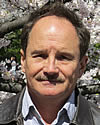 Joe Kirschvink |
2014 George P. Woollard Award
Presented to Joe Kirschvink
Citation by Benjamin Weiss and Francis Macdonald
We are delighted to present the 2014 Woollard Award to Joseph L. Kirschvink. Throughout his career, Joe has inspired students and has pushed the fields of paleomagnetism and geobiology with creative and provocative hypotheses.
Immediately upon finishing college, Joe generated some of the first magnetostratigraphic and chemostratigraphic records tied to radiometric ages that culminated in the construction of a geomagnetic polarity time scale and global paleogeography through the Cambrian Explosion. With this work, Joe identified large and rapid shifts in pole positions and proposed that the Earth experienced episodes of inertial interchange true polar wander, in whichthe outer solid Earth rotated tens of degrees over periods of just millions of years. This should have had profound implications sea level, the carbon cycle, and the evolution of life.
Using a paleomagnetic fold test, Joe confirmed that Neoproterozoic glacial deposits were deposited at equatorial latitudes and proposed the Snowball Earth hypothesis. Previous energy balance models suggested global glaciation was implausible because the ice albedo effect left no way out of a terminally glaciated state. Joe had the insight that a diminished hydrological cycle in combination with the release of volcanic CO2 would result in a super-greenhouse and catastrophic deglaciation. The Snowball Earth hypothesis has since been spectacularly confirmed with chemical evidence of extreme CO2 concentrations in globally synchronous cap carbonate sequences.
Joe also played a foundational role in biomagnetism. His work, led to the discovery of the magnetic sensory organelles used by animals to detect the geomagnetic field. This is the first new sensory organ discovered in higher animals since bat sonar was identified more than 70 years ago. With these and other discoveries, Joe became one of the original “geobiologists” who built this interdisciplinary field.
Joe’s contributions to paleomagnetic instrumentation and analysis are too numerous to mention but have profoundly changed the field.
On top of all of these research achievements, Joe has been an extraordinary mentor and teacher with a large and loyal following of former students that are active in science. Congratulations, Joe!
 2014 George P. Woollard Award — Response by Joe Kirschvink
2014 George P. Woollard Award — Response by Joe Kirschvink
Francis, Ben – thank you for your overly generous citation. I don't know where to begin my response. Although I have been a member of the Geological Society of America for nearly 40 years, I never thought in my wildest dreams that the Geophysics Division would consider a gadfly like me for the George P. Woollard award, particularly as I am a card-carrying Geobiologist (whatever that means). On the other hand, physics was my first intellectual love. I have been very fortunate in not really having to choose between physics, biology, and the earth sciences ever since I was an undergraduate at Caltech. Everything fascinated me from the beginning, and my faculty mentors never worried about what I was doing, as long as it was interesting. Many of them put deep fingerprints in my brain, including (at Caltech) Gene Shoemaker, Heinz Lowenstam, Lee Silver, James Bonner, and Dick Feynman, and (at Princeton) Al Fischer, Jason Morgan, Rob Hargraves, and Jim Gould. Many friends and colleagues elsewhere have been critically important too, including Paul Hoffman and Jim Kasting, in particular!
After joining the faculty at Caltech in 1981, I’ve had the enormous satisfaction of working with a group of hyper-stimulating students who have taken those old fingerprints on the brain and stretched them in numerous unexpected directions. In addition to Francis Macdonald and Ben Weiss, I’m particularly indebted to Dawn Sumner, Paul Filmer, Robin Chang, Rob Ripperdan, Linda Maepa, Rob Ferber, David Evans, Chris Pluhar, Jack Holt, José Hurtado, Kevin Boyce, Adam Maloof, Tim Raub, Isaac Hilburn, Cody Nash, Bob Kopp, Sonia Tikoo, Sarah Slotznick, and many others. Also, I would really like to thank my wife, Atsuko, for being extraordinarily patient with me, and our boys, Jiseki and Kōseki, for tolerating their geological names (‘Magnetite’ and ‘Gemstone’ in Japanese).
I suppose that there is a unifying theme in much of my work, namely magnetism. Magnets fascinate me. I was delighted when I realized that a frozen bit of animal tissue was essentially a rock, and then one could do rock magnetism on it. Heinz Lowenstam and I started this on chitons (a type of marine mollusk), whose teeth are capped with a hardening layer of biological magnetite. I was curious about how much magnetite these little animals could produce, which led to comparisons with the magnetotactic bacteria and the eventual discovery of magnetofossils. It also opened a new door of biophysics concerning how a magnetite-based receptor cell could act as a magnetic sense organ for migrating and homing animals. That has been a fun pursuit. We actually have a major project funded by the Human Frontiers Science Program, trying to train humans to consciously perceive the geomagnetic field. Perhaps someday field geologists won’t need their Brunton compasses any more!
Bringing this back to George P. Woollard, it is fitting to note that he was a pioneer in the construction and interpretation of large-scale gravity and magnetic anomaly maps, including some for the east coast of the United States. Having those maps, and later the digital data, were critical for helping us understand the magnetic navigation of birds and bees, and even crazy things like whale strandings. I'm not sure if this is “multidisciplinary", “interdisciplinary”, or what – but I certainly know it has been fun! And in my Woollard lecture I would like to upset paleontologists by suggesting that the Cambrian explosion might have been partially an artifact of true polar wander! Again, many thanks.
